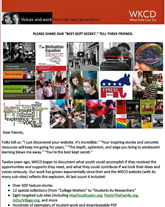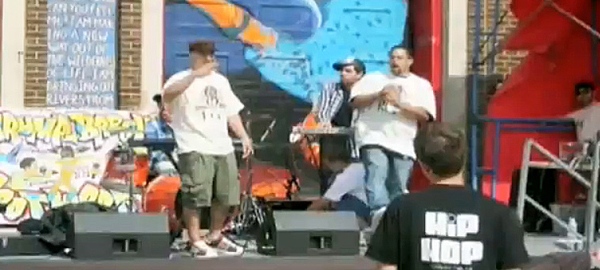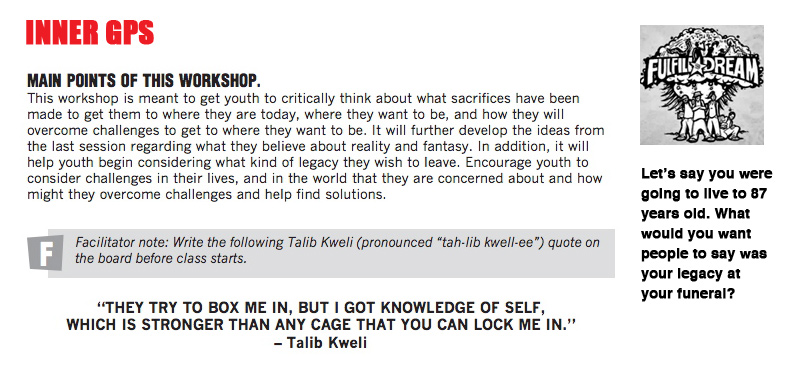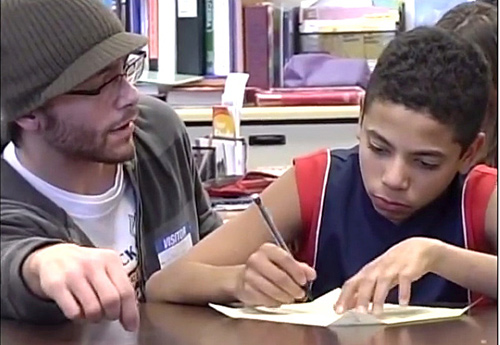SUBSCRIBE TO OUR____ NEWS BLAST
OTHER WKCD WEBSITES SPECIAL COLLECTIONS Students as Allies in School POPULAR WKCD PUBLICATIONS (PDFS] A Guide to Creating Teen- Cultural Conversations through Creative Writing Documenting Immigration Stories First Ask, Then Listen: How Your Students Can Help You Teach Them Better Making Writing Essential to Profiles of Politically Active Youth Queer Youth Advice for Educators The Schools We Need: Creating Small High Schools That Work for Us
|
Fulfilling the Dream: The Power of Hip Hop by BARBARA CERVONE | MARCH 25, 2014
CHICAGO, IL – David Rojas, a senior at Connecticut College, well remembers the day when a hip hop artist named Roberto Rivera walked into his classroom at Social Justice High School on Chicago’s West Side and announced that he was there to peddle hope. Rojas had just transferred to Social Justice, searching for a school that matched his restlessness. As a way to escape the community that “was boxing me in,” he signed up for an afterschool class called Fulfill the Dream. He liked that its medium was hip hop, he said, and that its message was change. “I’m a hope dealer,” Rivera told the group, “here to help you move from living the hood life to living the good life.” Rojas, then a high school junior, took up the challenge. “It wasn’t just college,” he remembered. “Roberto kept asking me what I wanted to do ten or fifteen years down the line.” Those were fresh words to youth like Rojas. In the neighborhoods where he and his classmates lived, the realities of daily life had a way of snuffing out thoughts of the future. “It’s not that the youth don’t want to get up,” he said. “It’s just that there’s no support to push then back up when they fail. It’s that simple.” It would be Rivera who took Rojas and others in his group on their first visit to downtown Chicago, just eight miles away from their Little Village neighborhood. And it would be Rivera who taught him how to weave his life experiences into powerful words and movement that hung in the air before a spellbound audience. When he was 16, Rojas gave a speech that earned him the Youth of the Year Award from the Boys and Girls Clubs of Chicago. Two years later, he headed to college with a prestigious Posse Scholarship. He told Rivera that he hoped to study abroad and travel the world—and then return home and have his own classroom. “I’m stayin’ in the game,” he said.
Turning pain into propane In 2008, when Roberto Rivera started The Good Life Organization and its signature program Fulfill the Dream, he envisioned a movement that would ignite disengaged youth with innovative curriculum and edu-tainment. By encouraging them to reach and dream, he might “turn pain into propane,” as he said. Youth scarred by loss, he reasoned, might process their grief through music, media, and movement, changing narratives of disenfranchisement into new ones of empowerment. Research was already linking hip hop with increased engagement and literacy among urban youth. Perhaps the principles of social and emotional learning might also dovetail with the core elements of this youth-driven art form. Five years later, Rivera would speak of a boy he called Carlos as he addressed the closing session of the 2013 Unreasonable Institute—a select network “giving high-impact entrepreneurs wings.” In elementary school, Rivera explained, Carlos was deemed “learning deficient” and assigned to special education classes. In middle school, his “misdirected entrepreneurship skills” got him kicked out. Carlos ran away from home, was arrested, went through drug rehabilitation, and at the tender age of 14 tried to take his life. Hands shot up when Rivera asked the audience, “Does anybody here know a Carlos, a young person struggling to find meaning and purpose in their lives?” He smiled, because that wasn’t the end of the story. Somehow, Carlos had figured out that his learning differences were not deficiencies. He used them to make his way to a Big Ten university, where he created his own major. He started solving problems in his community and won a Golden Rule award from former President Bill Clinton. He was named one of the top young change agents in America. In the months just ahead, he was starting a Ph.D. program. “Maybe you have guessed by now,” Rivera told his listeners. “I am Carlos.” Stories of transformation are Rivera’s stock in trade—along with changing adult perspectives on youth like Carlos. “We see these kids as ‘at risk,’ but risk isn’t necessarily a bad thing,” he explained. “Too often, as educators, we look at risk as something negative, a liability—that these kids have this fire of risk and that we need to put that fire out.” Rivera sees it differently. “That fire, that risk, can be channeled,” he said. “If you think about it, some of the most successful people in the world have learned to take calculated risks.”
A potent curricular mix Calculated risks require solid groundwork, however, and the Fulfill the Dream curriculum provides that. The workshops, ten in all, are as audacious as Rivera and the other hip hop artists that created them. Their blend of hip hop, media, and metaphor with reading, reflective writing, and action creates a potent mix of learning. In addition to a teaching guide, instructors receive two days of professional development before they start, then an additional day in the course of the workshop series. They are provided with local artists who come in and work with the youth. Sometimes, Fulfill the Dream is integrated into "regular" instruction; more often, it's an afterschool elective. Community-based organzations like the YMCA of Cincinnati have made the curriculum part of their afterschool programming. The first workshop, “Reality Check,” explores how the media and corporate America bind personal fulfillment to consumerism, marketing “fantasy definitions” of self and society. A CD of powerful stories from some of the best hip hop artists in the country align with each workshop and provide discussion prompts. “They try to box me in, but I got knowledge of self, which is stronger than any cage that you can lock me in,” says rapper Talib Kweli, for example. “Who is the ‘they’ in this stanza?” the workshop leader will ask students. “What are some ways that ‘they’ try to box us in? How do ‘they’ benefit? What are the consequences of being boxed in?” The second workshop, “Inner GPS,” leads students back to the sacrifices of civil rights leaders like Martin Luther King and Nelson Mandela—then forward to the continuing responsibility of rising generations to fight racial injustice. Hip hop “teaches us our need to learn from these heroes,” the educator’s guide explains: “to sample and build off them, to remix them into our own lives so that we can reclaim our histories and, in turn, regain our position to make history.” “Soul Bling,” the third unit, encourages students to discover their strengths and celebrate uniqueness. “Your Crew” addresses healthy relationships and challenges youth to develop a diverse support system that calls out “true greatness.” “Pimp My Ride” deals with grief and reflects on the power of forgiveness. Yahtzeni Gonzales, an alumna of the program and now a program assistant, recalled her early resistance when Rivera prompted her group to look within themselves in class discussions and self-reflective journals. “I was like, ‘Nah. I’ma get out of Fulfill the Dream. It’s too much information for me. This dude wants me to go all personal on him. I don't even know him.’ I was like, ‘Nah. I’m good.’” Her mom, a hip hop fan, convinced her to stay. Later she signed up to take the course twice more, finding her voice as a budding poet. Workshops six through eight focus on planning and action. “I Have a Dream Too!” challenges participants to develop an action plan that aligns with their personal vision. “Obstacles and Opportunities” shows youth how to use their voices in the face of roadblocks, and “Opportunities and Hurricanes” describes proactive steps they can take to traverse life’s hardest challenges. As the next to last workshop, “The Good Life Now!” encourages youth to unleash the power of “abundant living”: joy, friendship, service, justice. And the final unit, “The Great Life Legacy,” presses youth to solve social problems “authentically and creatively.” At the end of these ten weeks, participants must translate what they have learned into a creative piece: a rap, a poem, a song, a collage, a break dance. They must also develop a plan for how they will take this knowledge into the neighborhood and serve others. In community with their peers, they reflect on how they have changed and what they have given. Many students called the course one of the most demanding they had ever taken. “I blame Fulfill the Dream,” said Yahtzeni Gonzalez, “for making me want to stay in school.”
Evidence of effectiveness However unusual, the Fulfill the Dream curriculum draws from a research base that ranges from multiple intelligence and social-emotional learning theory to culturally relevant pedagogy. Its themes of leadership, relationships, and citizenship skills also echo those of the youth development field. Steady research on how hip hop culture can lift learning among disenfranchised youth has added to the program’s credibility. As its participants like to say, “The class helps us get our ships together.” To date, over 1,000 educators and social workers have received training, representing close to 100 organizations and 20,000 middle and high school-aged youth. A national network links educators and youth in seven cities. In the era of Common Core Learning Standards, the Fulfill the Dream curriculum also lines up with standards in English Language Arts/Literacy and Social Studies/History. Preliminary evaluations of the program are promising:
A new study by Purdue University will yield further data on the program’s effects. And clearly such metrics matter. Improved GPAs, reduced drop out rates, increased attendance, alignment with standards are the “coin of the realm” in the assessment world. But when Roberto Rivera and his crew of hip hop artist-instructors assess the effects of their program, they talk about thermodynamics: the huge amount of energy the program creates and how that energy continues long after the workshops end. They point to young people taking their grief and trauma and turning it into art, poetry, and dance; organizing block parties that bridge gang territories; creating town halls that hold local politicians accountable; staging annual hip hop revival events in cities across the country. “Every young person has not only the ability to solve problems on a standardized test, but the ability to solve problems in their communities as well,” Rivera often says. Yahtzeni Gonzalez tells with pride of the book One Voice Nation, which she and other students at Social Justice High School created in 2011 and published as an e-book with its own app. When they called for submissions from students in Fulfill the Dream’s national network, they were inundated with entries. “We had poetry, pictures, drawings, graffiti from kids in seven cities—from Chicago, L.A., the Bronx, Cincinnati, Connecticut,” she says. “The list goes on and on. The book has poems, amazing poems, which really touch you. We have drawings, cartoons, and graffiti that will make you laugh or cry. It all came from the positive energy of youth believing in their voices.” Gonzalez now serves on a leadership team of Fulfill the Dream alums across the country (including David Rojas at Connecticut College). The group is currently working on a new anthology of youth voices, this time from young people around the world. Emma Jackson, a junior at Ohio State University who serves on that team, recently started the Living the Good Life newsletter. It is though “caring for ourselves,” she noted there, “that we are able to, in turn, make the world a better place.” And it is through “joining our voices despite our differences that we realize the potential for community empowerment.” Rivera’s energy, meanwhile, just keeps growing. He has set his sights on a “change reaction that can alter society.” If two million young people engage in such action by 2020, he maintains, the nation’s high-school dropout rate would decrease by 50 percent and the U.S. economy would gain over $392 billion as a result. “Hip hop culture is the greatest case study in the history of the planet,” he declares, “of what can happen when disenfranchised youth find their voice and begin to transform themselves and the world around them.”
Click here to read excerpts from WKCD's extended interviews with Fulfill the Dream alums Yahtzeni Gonzales, Emma Jackson, and David Rojas. To learn more about the power of hip hop to reach urban youth and change the way we think about teaching and school design, see Hip Hop Genius: Remixing High School Education by Sam Seidel (R & L Education, 2011). For an inside look at the implementation of Fulfill the Dream in a group of schools in southern Illinois—including interviews with the students, teachers, and local artists—see Fulfill the Dream Overview (14:27 min). The Good Life Organization and Fulfill the Dream are continually evolving, fine tuning their strategies and seizing new opportunities. This is part of their strength. Several new studies on the program's effectiveness are also underway. To learn the latest, please contact jennifer@thegoodlifeorgnization.com.
What Kids Can Do, Inc. | info@whatkidscando.org | www.whatkidscando.org
|





